If you suspect that your cat has stomatitis, it is essential to visit your vet for a proper diagnosis and treatment plan. Stomatitis is a painful inflammatory disease that affects the mouth, and proper nutrition plays a crucial role in managing this condition. Knowing what to feed your cat is vital for their oral health and overall well-being.
Key Takeaways:
- Stomatitis is a severe inflammatory condition that affects a cat’s mouth and gums, and prompt veterinary care is crucial for effective management.
- Common symptoms of stomatitis include decreased appetite, excessive drooling, redness in the gums, and an unkempt coat.
- The exact causes of stomatitis are not fully understood, but dental disease and immune system disorders are believed to contribute to its development.
- Diagnosis involves a combination of clinical signs, physical examination, dental evaluation, and possibly a biopsy.
- Treatment options include medical management, dental interventions, pain management, and tooth extraction if necessary. Regular dental care and oral hygiene are essential for preventing and managing stomatitis in cats.
Understanding Feline Stomatitis
Feline stomatitis is a severe inflammatory condition that affects a cat’s mouth and gums. While the exact cause is unknown, factors such as dental disease and immune system disorders are believed to contribute to its development. Cats with stomatitis may exhibit symptoms such as decreased appetite, excessive drooling, redness in the gums, and an unkempt coat. If left untreated, stomatitis can be life-threatening. Prompt veterinary care and treatment are crucial to manage the condition effectively.
Feline stomatitis is a debilitating disease that causes significant pain and discomfort for cats. It is characterized by a widespread inflammation of the oral mucosa, affecting the gums, tongue, and throat. The exact cause of stomatitis remains unclear, but it is thought to be a result of the cat’s immune system overreacting to dental plaque and bacteria in the mouth. The inflammation can become chronic and severe, leading to a range of symptoms that can significantly impact a cat’s quality of life.
The symptoms of feline stomatitis can vary from cat to cat, but common signs include decreased appetite, excessive drooling, redness in the gums, and an unkempt coat. Cats may also show signs of discomfort when eating or grooming themselves. These symptoms are a result of the painful inflammation and can significantly impact a cat’s overall well-being. If you notice any of these symptoms in your cat, it is essential to seek veterinary care to diagnose and treat stomatitis promptly.
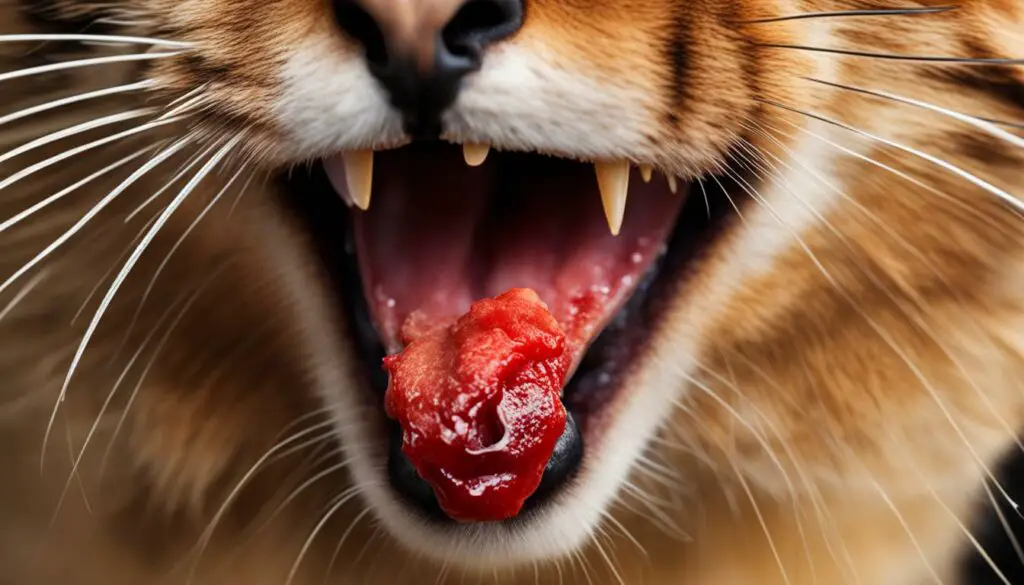
Effective management of feline stomatitis requires a multidimensional approach that addresses both the underlying cause and the symptoms. Treatment options may include dental interventions, such as tooth extractions or periodontal therapy, to remove the source of inflammation. Medications, such as pain relievers and anti-inflammatory drugs, may also be prescribed to alleviate discomfort and reduce inflammation. In severe cases, immunosuppressive therapy may be necessary to manage the immune response contributing to stomatitis.
Regular veterinary check-ups and ongoing dental care are crucial for cats with stomatitis. Routine dental cleanings, proper oral hygiene, and a tailored diet can help manage the condition and improve overall oral health. By working closely with a veterinarian, you can develop a comprehensive treatment plan that minimizes pain, reduces inflammation, and improves your cat’s quality of life.
Recognizing the Symptoms of Stomatitis
If you suspect that your cat may be suffering from stomatitis, it is crucial to be able to recognize the symptoms. Cats with stomatitis may exhibit various signs of oral pain and discomfort. These symptoms include:
- Excessive drooling
- Bad breath
- Weight loss
- Pawing at the face or mouth
- Decreased appetite
- Unkempt coat
- Red and inflamed gums
- Pain when the face is touched
- Lethargy
- Difficulty swallowing
If you notice any of these symptoms in your cat, it is important to consult with your veterinarian for further evaluation and treatment. Stomatitis is a painful condition that can significantly impact your cat’s quality of life, so prompt veterinary care is essential.
Examples of Stomatitis Symptoms:
“I noticed that my cat, Fluffy, was drooling excessively and had an odor coming from her mouth. She had also lost weight and seemed lethargic. When I examined her, I saw that her gums were very red and inflamed. Fluffy was clearly in pain, and I knew it was time to take her to the vet.”
By recognizing the symptoms of stomatitis and seeking veterinary care, you can help ensure that your cat receives the necessary treatment to manage the condition effectively.
Understanding the Causes of Stomatitis
Stomatitis in cats is believed to be an immune-mediated response, although the exact causes are not fully understood. Several factors contribute to its development, including dental diseases such as periodontal disease, viral infections like feline calicivirus, and underlying systemic conditions like FIV, FeLV, kidney disease, diabetes mellitus, and autoimmune disease. The immune system’s abnormal response to bacteria in the mouth triggers inflammation and leads to the painful symptoms of stomatitis.
To manage stomatitis effectively, it is crucial to identify and address the underlying contributing factors. Regular dental care, including professional dental cleanings and maintaining good oral hygiene at home, can help prevent dental diseases that may trigger stomatitis. Additionally, controlling viral infections through appropriate vaccination protocols and managing systemic conditions with the guidance of a veterinarian is essential.
While stomatitis can be challenging to treat, understanding the causes and managing the contributing factors can contribute to better outcomes for cats with this condition. Veterinary professionals play a crucial role in developing a comprehensive treatment plan that may include medical management, dental interventions, pain management, and, in severe cases, tooth extraction or surgery. With proper care and ongoing veterinary support, cats with stomatitis can experience improved quality of life.
Contributing Factors to Stomatitis:
- Immune-mediated response
- Dental diseases like periodontal disease
- Viral infections such as feline calicivirus
- Underlying systemic conditions like FIV, FeLV, kidney disease, diabetes mellitus, and autoimmune disease
Understanding the causes of stomatitis is crucial for effective management and treatment. By addressing these underlying factors, veterinarians can develop personalized strategies to alleviate pain, reduce inflammation, and improve oral health in cats with stomatitis.
| Cause | Description |
|---|---|
| Immune-mediated response | An abnormal immune response to bacteria in the mouth triggers inflammation and pain in the oral cavity. |
| Dental diseases | Conditions like periodontal disease can lead to the development of stomatitis. |
| Viral infections | Feline calicivirus is one of the viral infections that can contribute to stomatitis. |
| Underlying systemic conditions | Systemic diseases like FIV, FeLV, kidney disease, diabetes mellitus, and autoimmune disease can increase the risk of developing stomatitis. |
Diagnosing Stomatitis in Cats
Diagnosing stomatitis in cats involves a thorough evaluation of clinical signs, physical examination, and dental assessment. Your veterinarian will carefully examine your cat’s mouth for signs of inflammation, redness, and ulcers. They may also observe any behavioral changes or signs of pain that your cat may be exhibiting. This initial assessment helps in identifying potential oral health issues and assessing the severity of stomatitis.
During the physical examination, your vet will look for other potential underlying causes of stomatitis, such as viral infections or systemic diseases. They may also check your cat’s overall health and consider whether additional diagnostic tests are needed to rule out any contributing factors.
Dental examination and X-rays play a crucial role in diagnosing stomatitis. Your vet will thoroughly examine your cat’s teeth, gums, and oral cavity to identify any signs of dental disease or other abnormalities. Dental X-rays can help to assess the extent of dental disease, including periodontal disease and tooth root infections. In some cases, a biopsy may be recommended to confirm the diagnosis or rule out other oral conditions.
When to Consider a Biopsy
In certain cases, the diagnosis of stomatitis may require a biopsy. A biopsy involves taking a small sample of tissue from the affected area in the mouth and examining it under a microscope. This helps to confirm the presence of inflammation and rule out other oral diseases, such as oral cancer. Your vet will determine if a biopsy is necessary based on the severity and extent of your cat’s stomatitis and any other oral health concerns.
| Diagnostics Methods | Advantages | Disadvantages |
|---|---|---|
| Clinical Signs and Physical Examination | – Easy to perform | – Limited information on underlying causes – May not provide a definitive diagnosis |
| Dental Examination and X-rays | – Identifies dental disease and abnormalities – Assesses the severity of dental disease |
– Requires sedation or anesthesia – May not detect systemic causes |
| Biopsy | – Confirms the presence of inflammation – Rules out other oral diseases |
– Invasive procedure – Requires sedation or anesthesia – Potential complications |
Diagnosing stomatitis in cats is a comprehensive process that involves evaluating clinical signs, conducting a thorough physical and dental examination, and considering additional tests or biopsies if necessary. By understanding the diagnostic methods and collaborating closely with your veterinarian, you can ensure an accurate diagnosis and develop an effective treatment plan for your cat’s stomatitis.
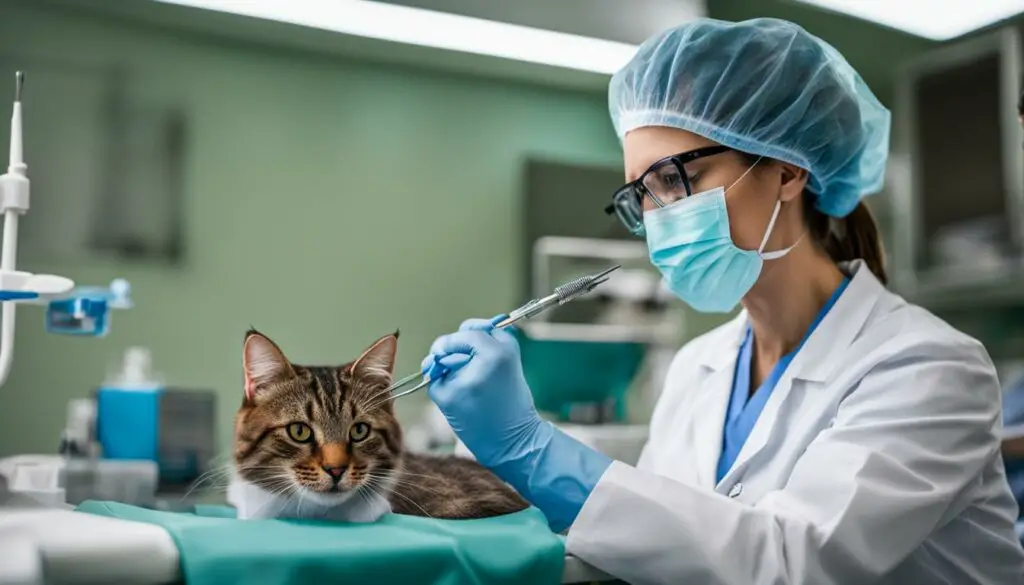
Treatment Options for Stomatitis
When it comes to treating stomatitis in cats, there are various options available that aim to provide relief from the pain and inflammation associated with this condition. The treatment approach typically involves a combination of medical management and dental interventions.
Medical management for stomatitis may include regular dental cleanings, dental x-rays to assess the extent of dental disease, and the use of oral rinses or gels to manage inflammation and bacteria in the mouth. Additionally, pain management is crucial to ensure your cat’s comfort throughout the treatment process. This may involve the use of pain medications prescribed by your veterinarian.
In cases where medical management alone is not effective, dental extractions may be necessary to alleviate symptoms and improve oral health. Tooth extraction involves removing the affected teeth and can help eliminate the source of inflammation. In more severe cases, surgery may be required to remove any remaining inflamed tissue and improve overall oral health.
In some instances, antibiotics may be prescribed to control secondary bacterial infections that can occur as a result of stomatitis. It’s important to follow your veterinarian’s instructions regarding the use of antibiotics and any other prescribed medications. Regular follow-up appointments with your vet will allow for the monitoring of your cat’s progress and adjustment of the treatment plan as needed.
| Treatment Options | Description |
|---|---|
| Medical Management | Includes regular dental cleanings, dental x-rays, and the use of oral rinses or gels to manage inflammation and bacteria. |
| Pain Management | Involves the use of pain medications to ensure the cat’s comfort throughout the treatment process. |
| Tooth Extraction | Removal of affected teeth to eliminate the source of inflammation and improve oral health. |
| Surgery | In severe cases, surgery may be required to remove remaining inflamed tissue and improve overall oral health. |
| Antibiotics | Prescribed to control secondary bacterial infections that may occur as a result of stomatitis. |
It’s important to note that the treatment approach for stomatitis may vary depending on the severity of the condition and the individual cat’s response to therapy. Your veterinarian will work with you to develop a tailored treatment plan that addresses your cat’s specific needs and maximizes their chances of recovery. Regular follow-up appointments and ongoing communication with your vet are essential for the management of stomatitis in cats.
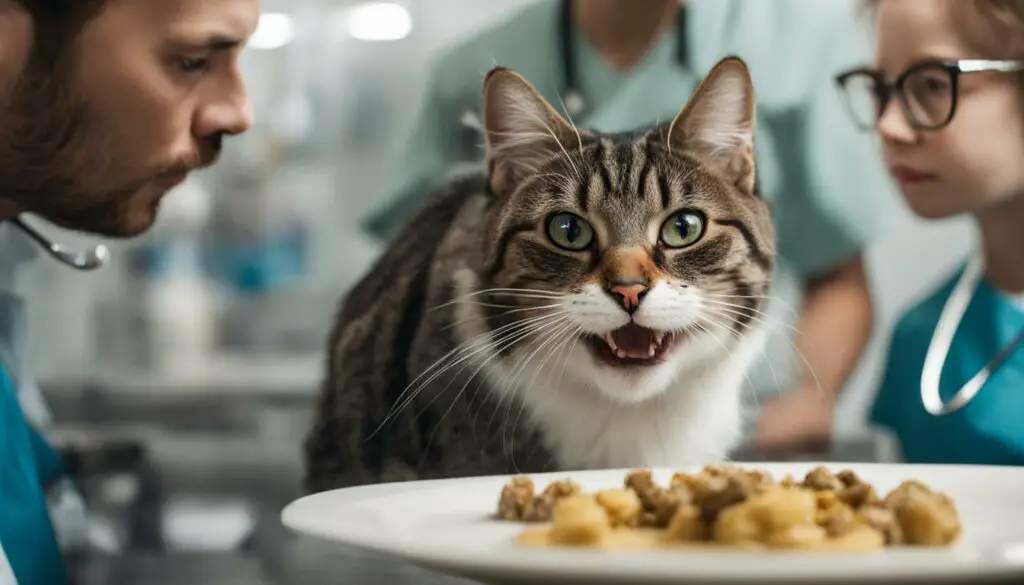
Remember, always consult with your veterinarian before making any decisions regarding the treatment of stomatitis in your cat. They can provide professional guidance and determine the most suitable treatment options based on your cat’s condition. With the right treatment plan in place, you can help alleviate your cat’s pain and improve their quality of life.
Dental Care and Oral Hygiene
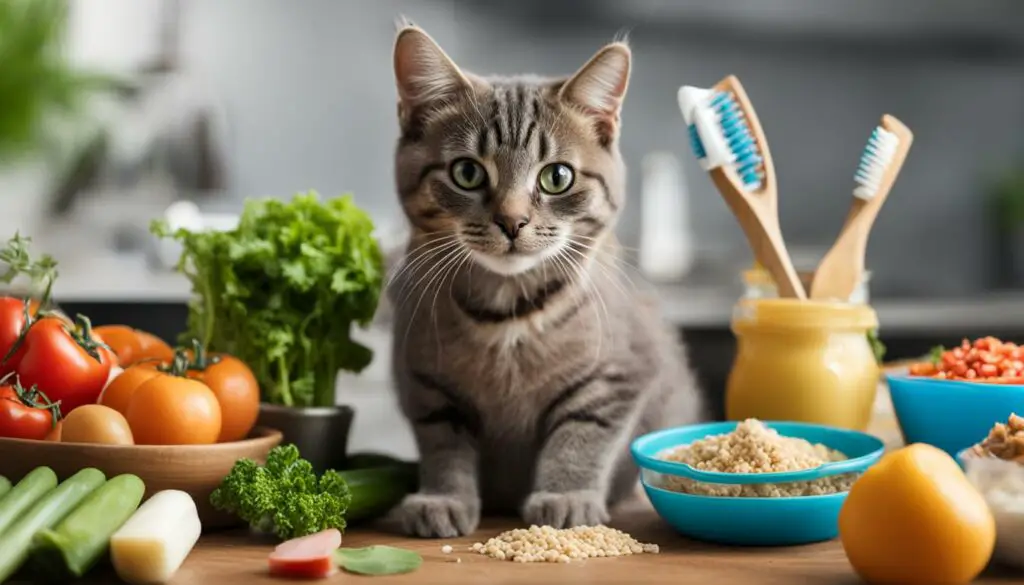
Ensuring proper dental care and oral hygiene is essential for managing stomatitis in cats and promoting their overall oral health. By establishing a regular dental care routine, you can help prevent dental diseases and minimize the risk of complications. Here are some key aspects of cat dental care:
Dental Care Routine
A consistent dental care routine is vital for maintaining your cat’s oral health. This routine should include regular toothbrushing using cat-friendly toothpaste. Use a soft-bristled toothbrush or a finger brush to gently clean your cat’s teeth and gums. Aim to brush their teeth at least two to three times a week to remove plaque and prevent the buildup of tartar. Be patient and gentle as your cat gets accustomed to the routine.
Dental Treats, Chews, and Toys
Offering dental treats, chews, and toys can help promote oral hygiene and prevent dental diseases. These specially designed products help remove plaque and tartar buildup while satisfying your cat’s natural chewing instincts. Look for products that are specifically labeled for dental hygiene and approved by veterinary experts. Regular use of dental treats, chews, and toys can provide additional support for your cat’s dental care routine.
Oral Rinses and Mouthwash
In addition to toothbrushing and dental treats, oral rinses and mouthwashes can be beneficial for maintaining oral hygiene in cats. These products can help reduce bacteria in the mouth and freshen your cat’s breath. Consult with your vet to determine the most suitable oral rinse or mouthwash for your cat’s specific needs and follow the instructions for use carefully.
Regular Veterinary Check-ups
Regular visits to your veterinarian are essential for monitoring your cat’s oral health and addressing any dental issues promptly. During these check-ups, your vet can perform professional dental cleanings, assess your cat’s dental hygiene, and identify any signs of dental disease. They may also recommend dental X-rays or further evaluations if necessary. By maintaining regular veterinary check-ups, you can stay proactive in preventing and managing stomatitis in your cat.
Diet Recommendations for Cats with Stomatitis
Cats with stomatitis require a special diet that promotes oral health and provides the necessary nutrients to manage their condition. When it comes to choosing the right cat food for stomatitis, there are several options to consider.
Dry Cat Food
Dry cat food can be a good option for cats with stomatitis as it helps to remove plaque and tartar buildup. Look for high-quality, grain-free dry cat food that is specifically formulated for dental health. These types of kibble often have a larger size and texture that encourages chewing, which can help with oral hygiene.
Wet Cat Food
Wet cat food can also be beneficial for cats with stomatitis as it provides hydration and is easier to eat than dry food. Opt for wet cat food that is formulated for dental health and free from artificial additives and fillers. The soft texture of wet food can be gentler on a cat’s inflamed gums and make eating more comfortable.
Prescription Cat Food
If your cat’s stomatitis is severe, your veterinarian may recommend a prescription cat food that is specifically designed for cats with oral health issues. These prescription diets often contain a combination of ingredients that help reduce inflammation, support the immune system, and improve oral health.
In addition to cat food, there are other diet-related recommendations that can help manage stomatitis in cats. Dental treats, dental chews, and dental toys can promote chewing and help clean the teeth. Oral rinses or mouthwashes recommended by your vet can also be used to maintain oral hygiene. Supplementing your cat’s diet with fish oil, which contains omega-3 fatty acids, can help reduce inflammation and support immune health. Vitamins C and E are antioxidants that can benefit your cat’s overall oral health. Probiotics and prebiotics can help maintain a healthy gut microbiome, which in turn can support the immune system.
Natural Remedies and Nutritional Supplements
When it comes to managing stomatitis in cats, natural remedies and nutritional supplements can play a complementary role in their treatment. These options can help boost the immune system, reduce inflammation, and promote overall oral health. Some beneficial natural remedies and nutritional supplements for cats with stomatitis include:
- Fish oil: Rich in omega-3 fatty acids, fish oil has anti-inflammatory properties that can help reduce oral inflammation and support immune health.
- Vitamin C and E: These antioxidants can strengthen the immune system and promote oral health in cats with stomatitis.
- Probiotics and prebiotics: These supplements can help maintain a healthy gut microbiome and improve immune function, which is essential for managing stomatitis.
Consult with your veterinarian before incorporating any natural remedies or supplements into your cat’s diet. They can provide guidance on the appropriate dosage and ensure that these supplements are safe and suitable for your cat’s specific needs. It’s important to note that natural remedies and supplements should be used alongside proper veterinary care and treatment options for the best results.

Veterinary Diets and Cat Dental Health Products
When it comes to managing stomatitis in cats, veterinary diets and cat dental health products can play a significant role in promoting oral health and overall wellbeing. These specialized diets are formulated to support dental health and provide the necessary nutrients to help alleviate symptoms and reduce the risk of dental disease. In addition to veterinary diets, there are various cat dental health products available that can assist in maintaining good oral hygiene.
Veterinary Diets
| Product Name | Description |
|---|---|
| Prescription Dental Diet | A specially formulated cat food designed to promote dental health and provide essential nutrients. |
| Grain-Free Cat Food | A cat food option that eliminates grains, which can contribute to dental plaque and tartar buildup. |
| Soft Cat Food | Soft cat food that is easier to chew, making it more comfortable for cats with oral health issues. |
Dental health products, such as dental treats, chews, toys, oral rinses, and toothbrushing with cat-friendly toothpaste, can also support your cat’s oral hygiene. These products help to reduce plaque and tartar buildup, prevent dental disease, and freshen your cat’s breath. It’s essential to choose products specifically designed for cats and consult with your veterinarian for recommendations tailored to your cat’s condition.
Cat Dental Health Products
| Product | Description |
|---|---|
| Dental Treats | Chewable treats that promote dental health and help remove plaque and tartar. |
| Dental Chews | Chewable products that assist in removing plaque and improve oral hygiene. |
| Dental Toys | Toys designed to encourage chewing and help clean teeth and gums. |
| Oral Rinses | Liquid solutions that can be applied to your cat’s mouth to help freshen breath and reduce bacteria. |
| Toothbrushing | Regular toothbrushing with cat-friendly toothpaste is a fundamental part of maintaining good oral hygiene in cats. |
| Dental Gels | Gels that can be applied to your cat’s teeth and gums to help prevent plaque and tartar buildup. |
By incorporating veterinary diets and cat dental health products into your cat’s daily routine, you can support their oral health and reduce the severity of stomatitis symptoms. It’s important to consult with your veterinarian for personalized advice and guidance on the most suitable products for your cat’s specific needs. Together, with proper nutrition and dental care, you can help improve your cat’s quality of life and ensure their dental health is maintained.
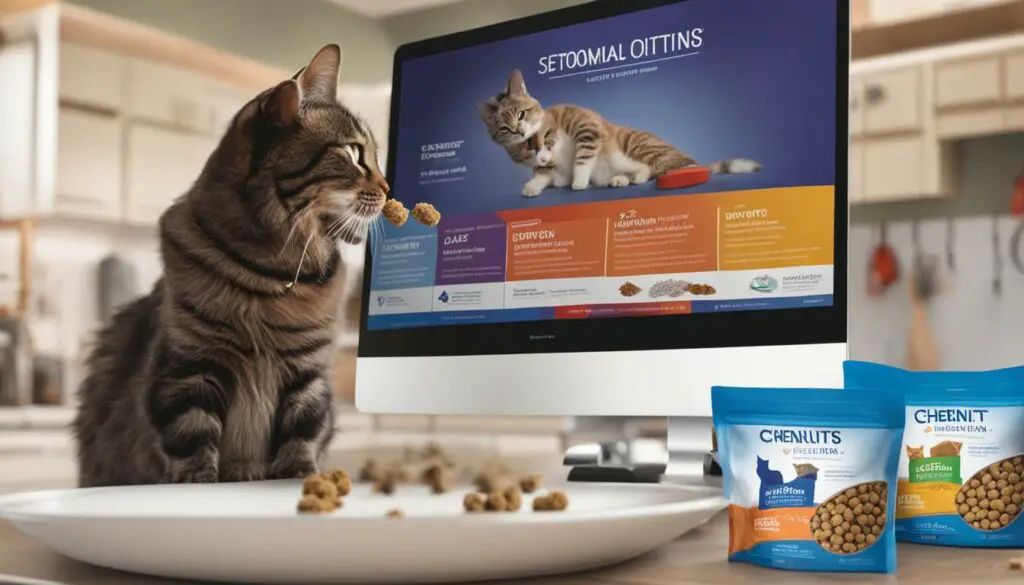
Importance of Cat Dental Care Routine
Establishing a regular cat dental care routine is essential for preventing dental issues and maintaining your cat’s overall oral health. A consistent dental hygiene routine can help prevent dental diseases, such as periodontal disease and gingivitis, which can be painful for your cat and lead to more severe health issues if left untreated.
Regular dental cleanings performed by your veterinarian can effectively remove plaque and tartar buildup, significantly reducing the risk of dental disease. These cleanings typically involve scaling and polishing the teeth under general anesthesia, ensuring a thorough and efficient cleaning process. Your vet can also perform a comprehensive dental examination, which may include dental X-rays to identify any hidden dental problems or issues beneath the gumline.
To maintain your cat’s dental hygiene at home, you can introduce toothbrushing into their routine. Use a cat-friendly toothbrush and toothpaste, as human products can be harmful to cats. Brushing your cat’s teeth a few times a week can help remove plaque and prevent the formation of tartar. Initially, your cat may resist toothbrushing, so it’s important to take it slow and gradually introduce it over time. Reward your cat with praise and treats after each successful toothbrushing session to associate it with positive experiences.

Benefits of a Cat Dental Care Routine
Implementing a cat dental care routine offers several benefits for your feline friend:
- Prevents dental diseases: Regular dental cleanings and toothbrushing help prevent the development of dental diseases such as periodontal disease and gingivitis.
- Reduces dental pain and discomfort: By maintaining good oral hygiene, you can minimize dental pain and discomfort for your cat.
- Improves overall health: Dental diseases can have systemic effects on your cat’s health. By preventing such diseases, you contribute to your cat’s overall well-being.
- Early detection of dental issues: Regular dental examinations can help identify dental problems early, allowing for prompt treatment and intervention.
- Cost-effective in the long run: Preventing dental diseases through regular dental care can help avoid costly dental procedures and treatments.
Aside from toothbrushing, you can also supplement your cat’s dental care routine with dental treats, toys, and rinses that promote oral health. Dental treats and toys encourage chewing, which can help remove plaque, while rinses can help reduce bacteria in the mouth. However, always consult with your veterinarian before introducing any new dental care products to ensure they are safe and suitable for your cat.
| Regular Dental Care | Benefits |
|---|---|
| Regular dental cleanings by a veterinarian | – Thoroughly removes plaque and tartar buildup – Identifies and treats dental issues early – Reduces the risk of dental diseases |
| Toothbrushing using cat-friendly toothpaste | – Removes plaque and prevents tartar formation – Decreases dental pain and discomfort – Promotes overall oral health |
| Supplementing with dental treats, toys, and rinses | – Enhances chewing, which aids in plaque removal – Reduces bacteria in the mouth – Supports oral hygiene |
Managing Stomatitis for Improved Quality of Life
Managing stomatitis in cats requires a comprehensive approach that focuses on providing relief and improving their overall quality of life. Treatment options may include a combination of dental interventions, pain management, tooth extractions, and surgery if necessary. It’s important to work closely with your veterinarian to develop a personalized treatment plan that addresses your cat’s specific needs.
Dental interventions play a crucial role in managing stomatitis. This may involve regular dental cleanings, which help remove plaque and tartar buildup that can contribute to inflammation. In severe cases, tooth extractions may be necessary to eliminate the source of pain and infection. Surgical interventions, such as laser therapy or cryosurgery, can also be considered to reduce inflammation and promote healing.
Pain management is essential to ensure your cat’s comfort. Your veterinarian may prescribe pain medications or recommend alternative therapies such as acupuncture or physical therapy. By addressing pain, you can help improve your cat’s appetite, overall well-being, and quality of life.
Long-term care is crucial for managing stomatitis effectively. This includes regular follow-up appointments with your veterinarian to monitor your cat’s progress and make any necessary adjustments to the treatment plan. It’s important to continue practicing good oral hygiene at home, such as regular toothbrushing and providing dental treats or toys. Additionally, maintaining a balanced and nutritious diet can help support your cat’s immune system and oral health.
Dental Interventions for Stomatitis Treatment
When it comes to managing stomatitis in cats, dental interventions are a key component of the treatment plan. These interventions aim to remove the source of inflammation and address any underlying dental disease. The following table provides an overview of common dental interventions used in stomatitis treatment:
| Treatment Option | Description |
|---|---|
| Tooth Extractions | Removal of severely affected teeth to eliminate the source of pain and reduce inflammation. |
| Laser Therapy | Use of laser technology to reduce inflammation, promote healing, and alleviate pain. |
| Cryosurgery | Freezing of inflamed tissues to reduce inflammation and promote healing. |
It’s important to note that the appropriate dental interventions for your cat will depend on the severity of their stomatitis and the extent of dental disease present. Your veterinarian will assess your cat’s condition and recommend the most suitable treatment options to improve their oral health and quality of life.
Challenges and Successes in Stomatitis Treatment
Managing stomatitis in cats can be a challenging process that requires a combination of medical management, dental interventions, and potentially surgical intervention. Stomatitis is a life-threatening condition that can cause significant pain and discomfort for cats, affecting their ability to eat and enjoy a good quality of life. However, with appropriate treatment and care, many cats with stomatitis experience improvements in their symptoms and overall well-being.
One of the main challenges in stomatitis treatment is finding the most effective approach for each individual cat. Medical management, such as dental cleanings, oral rinses, and pain management, may be sufficient for some cats to control the inflammation and reduce the symptoms. However, other cats may require more aggressive intervention, including tooth extractions or even surgery, to alleviate the pain and manage the condition effectively.
Another challenge in stomatitis treatment is the cat’s response to therapy. Every cat is unique, and their response to treatment can vary. Some cats may show significant improvement with the chosen treatment plan, while others may have a more limited response. It may take time to find the most suitable approach for each cat, and frequent follow-ups with the veterinarian are necessary to monitor the progress and make adjustments if needed.
Despite the challenges, there have been many successes in stomatitis treatment. With appropriate medical management and dental interventions, many cats experience a significant reduction in symptoms and an improved quality of life. Dental cleanings, tooth extractions, and surgical interventions can effectively remove the source of inflammation and provide long-term relief. Additionally, ongoing care and regular veterinary check-ups are essential to maintaining the cat’s oral health and managing any potential flare-ups.
Quotes:
“Proper management of stomatitis in cats can be complex, but with the right treatment approach and ongoing care, many cats can live comfortable lives.” – Dr. Smith, Veterinarian
“Each cat is unique, and what works for one may not work for another. It’s crucial to have patience and work closely with your veterinarian to find the most suitable treatment plan for your cat.” – Dr. Johnson, Feline Specialist
In conclusion, managing stomatitis in cats is a multi-faceted process that requires a customized approach. While there may be challenges along the way, many cats respond well to treatment and experience an improved quality of life. With proper medical management, dental interventions, and ongoing care, it is possible to effectively manage stomatitis and alleviate the pain and discomfort for our feline companions.
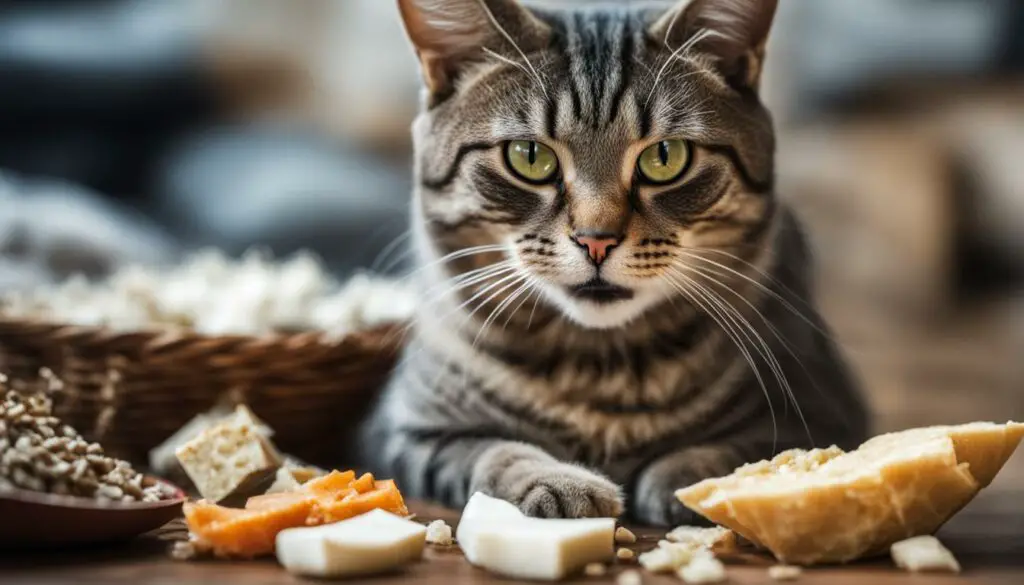
Conclusion
Proper nutrition plays a crucial role in managing stomatitis in cats and promoting their overall oral health. By understanding the causes, symptoms, and treatment options for stomatitis, you can take proactive steps to support your cat’s oral well-being. Working closely with your vet to develop a comprehensive treatment plan that includes a balanced diet, appropriate dental care routine, and necessary medications or surgical interventions can help alleviate your cat’s pain and improve their quality of life.
When it comes to feeding a cat with stomatitis, there are several diet recommendations to consider. Wet cat food, prescription cat food formulated for dental health, and soft cat food that is easier to chew can be beneficial options. Additionally, incorporating dental treats, chews, toys, and oral rinses into their diet can help support oral hygiene. Supplementation with fish oil, omega-3 fatty acids, vitamin C, vitamin E, probiotics, and prebiotics can also help boost their immune system and promote oral health.
It’s important to establish a regular dental care routine for your cat to prevent and manage stomatitis. This routine can include regular dental cleanings performed by your vet, toothbrushing using cat-friendly toothpaste, and offering dental treats or toys for chewing. By practicing good oral hygiene and providing appropriate dental care, you can reduce the risk of dental disease and promote overall oral health in your cat.
Remember to consult with your veterinarian for personalized advice and guidance tailored to your cat’s specific needs. They can provide further recommendations on feeding, dental care, and treatment options to effectively manage stomatitis and improve your cat’s oral health.

Frequently Asked Questions
- What should I feed my cat with stomatitis?
- What can I do to maintain my cat’s oral hygiene?
- Are there any natural remedies or supplements that can help manage stomatitis?
When it comes to feeding a cat with stomatitis, it’s important to choose a diet that promotes oral health. Wet cat food, prescription cat food formulated for dental health, and soft cat food that is easier to chew are recommended options. Additionally, incorporating dental treats, chews, toys, and oral rinses into their diet can help support oral hygiene.
Establishing a regular dental care routine is crucial for preventing and managing stomatitis. This routine can include regular dental cleanings performed by your vet, toothbrushing using cat-friendly toothpaste, and offering dental treats or toys for chewing. Regular care helps maintain good dental hygiene, reduces the risk of dental disease, and promotes overall oral health in cats.
Alongside a balanced diet, natural remedies and nutritional supplements can complement the treatment of stomatitis in cats. Fish oil, rich in omega-3 fatty acids, can reduce inflammation and support overall immune health. Vitamin C and E are antioxidants that can enhance the immune system and promote oral health. Probiotics and prebiotics can help maintain a healthy gut microbiome and improve immune function. Consult with your vet before adding any natural remedies or supplements to your cat’s diet.
References
As a responsible cat owner, it is essential to understand the causes, symptoms, and treatment options for stomatitis in cats. Stomatitis is a painful inflammatory disease that affects the mouth and can have a severe impact on a cat’s overall well-being. Dental diseases and immune system disorders are believed to contribute to the development of stomatitis in cats. Therefore, proper medical management, including dental cleanings, tooth extractions, and pain management, is necessary.
In the treatment of stomatitis, dental interventions play a crucial role. Regular dental cleanings and tooth extractions may be necessary to alleviate symptoms and improve oral health. Additionally, pain management is vital to ensure your cat’s comfort throughout the treatment process. Working closely with your veterinarian and following their recommended treatment plan is essential for managing stomatitis effectively.
In severe cases, surgical intervention may be required. This can involve the removal of affected teeth or more extensive oral surgery. Each cat’s response to therapy may vary, and the success of treatment depends on individual factors. Regular follow-up appointments with your vet and ongoing care are crucial for monitoring and managing stomatitis in cats.
By understanding the importance of dental care and medical management in treating stomatitis, you can take proactive steps to support your cat’s oral health and overall well-being. Remember to consult with your veterinarian for personalized advice and guidance tailored to your cat’s specific needs.
FAQ
What is stomatitis in cats?
Stomatitis is a painful inflammatory disease that affects a cat’s mouth and gums.
What causes stomatitis in cats?
The exact cause is unknown, but dental disease and immune system disorders are believed to contribute to its development.
What are the symptoms of stomatitis in cats?
Symptoms include excessive drooling, bad breath, weight loss, decreased appetite, red and inflamed gums, and difficulty swallowing.
How is stomatitis diagnosed in cats?
Diagnosis involves a combination of clinical signs, physical examination, and dental evaluation by a veterinarian.
How is stomatitis treated in cats?
Treatment involves a combination of medical management, dental interventions, pain management, and tooth extractions if necessary.
How can I prevent stomatitis in my cat?
Establishing a regular dental care routine and practicing good oral hygiene can help prevent and manage stomatitis in cats.
What should I feed my cat with stomatitis?
Wet cat food, prescription cat food formulated for dental health, and soft cat food are recommended for cats with stomatitis.
Are there any natural remedies or supplements that can help with stomatitis?
Fish oil, omega-3 fatty acids, vitamin C, vitamin E, probiotics, and prebiotics can complement the treatment of stomatitis in cats.
Are there any specific cat dental health products that can help with stomatitis?
Dental treats, chews, toys, oral rinses, and toothbrushing with cat-friendly toothpaste can help maintain dental hygiene and reduce the risk of dental disease.
How important is a cat dental care routine for managing stomatitis?
Establishing a cat dental care routine is crucial for preventing and managing stomatitis in cats.
Can stomatitis be cured in cats?
While stomatitis is a potentially life-threatening condition, many cats respond well to treatment and experience improved quality of life.
Where can I find more information about stomatitis in cats?
For more information, you can refer to the references provided below.
Source Links
- https://www.thesprucepets.com/how-to-treat-stomatitis-in-cats-4768670
- https://www.purina.co.nz/articles/cats/health/dental/stomatitis-in-cats
- https://petmd.com/cat/conditions/mouth/c_ct_stomatitis








